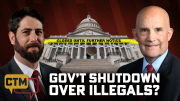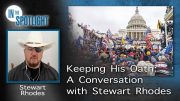A coterie of congressmen are secretly meeting to concoct a plan to impeach President Donald Trump, the New Yorker reports.
Writing for the magazine, Evan Osnos reports that “Trump’s critics are actively exploring the path to impeachment or the invocation of the Twenty-fifth Amendment, which allows for the replacement of a President who is judged to be mentally unfit.”
Who are these mystery conspirators?
Osnos claimed during an appearance on MSNBC,
This is a conversation that people are having around the dinner table, it’s one people have at the office, members of Congress are talking about it in private and the question is very simple: is this a president who is able to do the job and is able to go the distance?
While President Trump has demonstrated disdain for several key constitutional restraints on his power, it still seems a bit cowardly to claim “members of Congress” are mulling over tactics for taking down the president without naming those lawmakers.
As for the 25th Amendment, even the president’s most vicious critics among the mainstream media admit that this tactic is doomed.
In an article published in February, Salon called any talk of invoking the 25th Amendment as a way to dump Trump “unambiguous, raving madness.”
Osnos seems undeterred by his comrades’ evaluation of the likely efficacy of such a scenario, insisting that “there has been considerable speculation about Trump’s physical and mental health.”
While the 25th Amendment is purportedly the lever this secret group of lawmakers are using to pry President Trump out of the White House, it is worthwhile to look at the history of how presidents are constitutionally removed from office.
An excellent summary of this topic was written in 2010 by Robert Gilbert, a political science professor at Northeastern University. Here’s the relevant portion of his article:
In September 1787, they inserted the following clause into the draft Constitution: “[I]n case of [the President’s] removal as aforesaid, death, absence, resignation or inability to discharge the powers and duties of his office, the vice-president shall exercise those powers and duties until another President be chosen, or until the inability of the President be removed.”
A few days later, however, the draft constitution went to the Committee of Style for polishing, and this particular provision came back to the Framers in a quite different form. It then read: “In case of the removal of the president from office, or of his death, resignation, or inability to discharge the powers and duties of the said office, the same shall devolve on the vice-president.”
This wording — which was accepted by the Framers and incorporated into the Constitution as Article II, Section 1, Clause 5 — presented three significant problems:
(1) It is not clear to what “the same” refers. Do these words refer to the presidential office or to the powers and duties of the presidential office? The difference between the two is significant. If the presidential office passes to the vice president, the vice president becomes President; if the powers and duties of the office pass to the vice president, the vice president serves only as acting president. The latter is what the Framers seemed to intend, but their intentions became clouded in the final wording of the Constitution.
2) It is not clear what the Framers meant by “inability.” Also unclear is who determines “inability,” how “inability” is determined, and who determines when and if “inability” has ended.
3) The Framers placed in the same sentence of the Constitution three permanent conditions under which a president may leave office (removal, death, and resignation) with one temporary or even fleeting condition (inability). If the vice president inherits the office of the presidency when any one of these conditions exists, it is unclear whether a disabled president could get back the office after the inability ended. It is not surprising, then, that, for much of American history, presidents were reluctant to admit publicly that they were ill or disabled because this admission might have provoked a constitutional crisis.
Gilbert goes on to rehearse a rarely remembered episode in American history, an episode that served to clear up the constitutional language regarding the transfer of power from president to vice-president.
In 1841, Gilbert explains, President William Henry Harrison died in office and almost immediately vice-president John Tyler insisted that he was the new chief executive, not just some presidential pinch-hitter. Gilbert continues:
Some of his political contemporaries disagreed. Former President John Quincy Adams, a member of the House of Representatives at the time, wrote in his diary, “I paid a visit this morning to Mr. Tyler, who styles himself President of the United States, and not Vice-President, acting as President, which would be the correct style.”
On the floor of the Senate, Senator William Allen of Ohio raised a troubling question. If a Vice President becomes President when the President dies, resigns, is removed, or is disabled, what happens if a President recovers from a disability only to find the Vice President claiming to be President? “What would become of the office? Was it to vibrate between the two claimants?” He then warned that if the “office” of President devolved on the Vice President in a succession event, “the most fearful convulsions might follow.”
Tyler, however, was fiercely determined, and insisted that he was, in fact, the nation’s new President. To drive home the point, he took the presidential oath of office, gave an inaugural address in which he proclaimed that the presidential office had devolved on him and moved into the White House. Faced with his intransigence, Congress finally acquiesced. This created a powerful precedent: when the presidency was vacated permanently, the Vice President became President of the United States rather than Acting President.
Over a century later, the Twenty-Fifth Amendment would codify the precedent set by John Tyler, an action Professor Gilbert claims “overturns the Framers’ original intentions….”
Once again, the wisdom of the Founders was nullified by one man’s mania for political power.
Finally, after chronicling evidence of President Trump’s “malignant narcissism,” in an exercise in exploring potential paths that could lead to removing President Trump via the Twenty-Fifth Amendment’s “unable to discharge the powers and duties of his office” clause, Osnos quotes Professor Gilbert as saying, “If the statements get too strange, then the Vice-President might be able to do something. But if the President is just being himself—talking in the same way that he talked during the campaign—then the Vice-President and the Cabinet would find it very difficult.”
After admitting that the first two-thirds of his article was impotent pragmatically, Osnos hitches his hopes of undoing the last presidential election to the wagon of impeachment.
Although likely to prove equally as futile, at least the impeachment gambit has some support from the Founders.
Article II, Section 4 of the U.S. Constitution provides the power to check corruption of all federal officials: “The President, Vice President and all civil Officers of the United States, shall be removed from Office on Impeachment for, and Conviction of, Treason, Bribery, or other high Crimes and Misdemeanors.”
In The Federalist, No. 65, Alexander Hamilton promoted the power of impeachment to protect public trust:
A well-constituted court for the trial of impeachments is an object not more to be desired than difficult to be obtained in a government wholly elective. The subjects of its jurisdiction are those offenses which proceed from the misconduct of public men, or, in other words, from the abuse or violation of some public trust. They are of a nature which may with peculiar propriety be denominated POLITICAL, as they relate chiefly to injuries done immediately to the society itself. [Emphasis in original.]
The Framers of the Constitution, while meeting in Philadelphia in 1787 recognized the necessity of writing a remedy into our founding charter for the disease of official abuse of the confidence of the people. Impeachment was the remedy and it was a central element of the overall scheme of tethering public servants to the anchor of popular consent.
On July 20, 1787, James Madison recorded the following question asked by George Mason during debates on the proper method of keeping federal officers inside their constitutional cages.
“No point is of more importance than that the right of impeachment should be continued. Shall any man be above justice?” Madison asked.
On that same hot afternoon session, Madison himself described impeachment as an “indispensable” provision for “defending the community against the incapacity, negligence or perfidy” of government officials.
So, while journalists such as Osnos spend time typing out clickbait claims of secret cabals of congressmen conspiring to oust the president, those who genuinely want to push the president out of the Oval Office would be better off pursuing impeachment.




